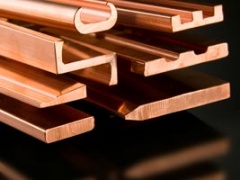Copper and copper alloy products
| Infobox on Copper and copper alloy products | |
|---|---|
| Example of Copper and copper alloy products |  |
| Facts | |
| Origin | - |
| Stowage factor (in m3/t) | - |
| Humidity / moisture | - |
| Ventilation | - |
| Risk factors | See text |
Copper and copper alloy products
Contents
Description / Shipment and Storage / Risk factors
Copper is a ductile metal with very high thermal and electrical conductivity. Pure copper is soft and malleable; a freshly exposed surface has a reddish-orange color. It is used as a conductor of heat and electricity, a building material, and a constituent of various metal alloys.
Numerous copper alloys exist, many with important uses. Brass is an alloy of copper and zinc. Bronze usually refers to copper-tin alloys, but can refer to any alloy of copper such as aluminium bronze. Copper is one of the most important constituents of carat silver and gold alloys and carat solders used in the jewellery industry, modifying the colour, hardness and melting point of the resulting alloys.
The alloy of copper and nickel, called cupronickel, is used in low-denomination statuary coins, often for the outer cladding. The US 5-cent coin called nickel consists of 75% copper and 25% nickel and has a homogeneous composition. The 90% copper/10% nickel alloy is remarkable by its resistance to corrosion and is used in various parts being exposed to seawater. Alloys of copper with aluminium (about 7%) have a pleasant golden colour and are used in decorations. Copper alloys with tin are part of lead-free solders.
Copper and copper alloy products include sheet, strip, tube, wire, other wrought shapes and castings. When thin and of a high surface, scratches, gougings, tears, etc., may ruin de product to the extent of the damaged area. Sea-water and fresh water produce stains, and sea water may give rise to some corrosion. If stains are superficial, the product can be used, but if rough and pitted, the material may be rejected. Slight corrosion by general atmospheric conditions may also occur. Manufacturing defects in castings, such as scabbiness, roughness or folds (‘pinches’), can be readily identified, as these cannot be produced by rough handling or by corrosion in transit.
Surface defects to cast or wrought products, apart from corrosion pits, scratches and dents, can usually be attributed to faulty manufacture. Scabbiness is caused by the metal splashing when it is poured into the mould and cooling in droplets on the side. An oxide film is formed around these droplets which prevents them uniting with the rest of the metal in the ingot. Roughness is caused by the ingot sticking to the mould, causing a tearing of the surface on removal. Folds (‘pinches’) are caused in casting with too low a pouring rate, allowing a series of oxide films to be formed. All three defects originate in a faulty ingot and the faults remain because of the inability of oxidized surfaces to weld together.
Superficial staining or light corrosion to wrought products may be removed by the use of mild abrasives, and provided the product is not made to accurate dimensions, scratches, etc., may also be polished out with an abrasive. Solutions containing ammonia should not be used for cleaning.
Application
The major applications of copper are in electrical wires (60%), roofing and plumbing (20%) and industrial machinery (15%). Copper is mostly used as a metal, but when a higher hardness is required it is combined with other elements to make an alloy (5% of total use) such as brass and bronze. A small part of copper supply is used in production of compounds for nutritional supplements and fungicides in agriculture. Machining of copper is possible, although it is usually necessary to use an alloy for intricate parts to get good machinability characteristics.











